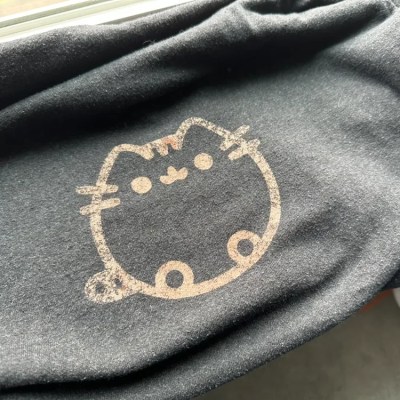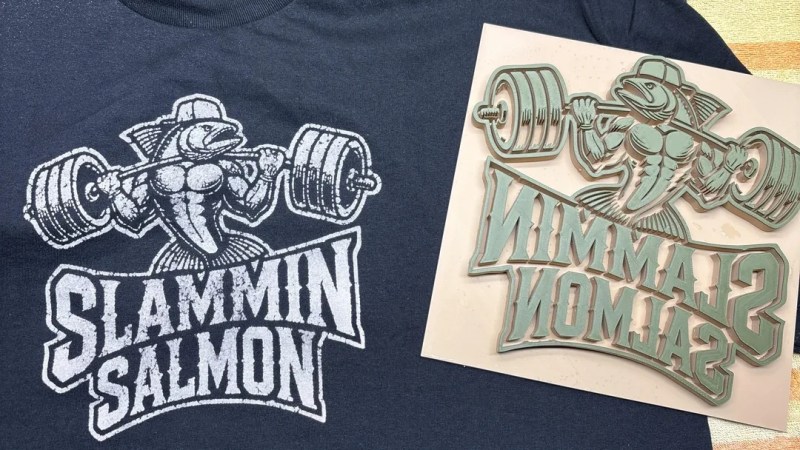Bleach is a handy way to mark fabrics, and it turns out that combining bleach with a 3D-printed design is an awfully quick-working and effective way to stamp a design onto a shirt.

While conceptually simple, the details make the difference. Spraying bleach onto the stamp surface helps get even coverage, and having the stamp facing “up” and lowering the shirt onto the stamp helps prevent bleach from running where it shouldn’t. Prompt application of hot air with a heat gun (followed by neutralizing or flushing any remaining bleach by rinsing in plenty of cold water) helps keep the edges of the design clean and sharp.
We wondered if combining techniques with some of the tips on how to 3D print ink stamps would yield even better results. For instance, we notice the PLA stamp (used to make the design in the images here) produces sharp lines with a slightly “eroded” look overall. This is very much like the result of inking with a stamp printed in PLA. With a stamp printed in flex filament, inking gives much more even results, and we suspect the same might be true for bleach.
Of course, don’t forget that it’s possible to 3D print directly onto fabric if you want your designs to be a little more controlled (and possibly in multiple colors). Or, try silkscreening. Who knew there were so many options for putting designs onto shirts? If you try it out and learn anything, let us know by sending in a tip!















Cool idea!
FWIW, a solution of white vinegar and water neutralizes bleach much faster than water alone. I have never tried it on fabric so by all means test on scrap first. For that matter, just about any mildly acidic solution – citric acid, for example – will neutralize chlorine bleach.
Do you want to create chlorine gas?
Mixing bleach with acid doesn’t sound safe tbh
Fume hood?
To be clear, we’re talking about both a small amount of bleach – just enough to show the image without running or bleeding – and a very weak acid. Both the rate of chlorine gas production, and the total amount produced, pose no danger at all. It’s not nearly the same as, say, dumping a cup of vinegar into a vat of bleach.
“Do you want to create chlorine gas” – yes. Yes that’s exactly what you want to do. You want the chlorine to go away. It goes away by evaporating, turning to gas.
If you’re making 500 shirts, you probably want to be outdoors when you do this. Really, just go ahead and go out on the porch even if you’re just doing a couple shirts, because why not.
You want to be aware of what you’re doing – don’t do this in a half bath with the door closed, then stay in there with your face in the mixture for 10 minutes. It’s dangerous when people have no idea they just made a strong irritant, then ignore what their body is telling them. Common sense should be applied.
Liberated Clorine gas is heavy &stay on the ground .it will not go up in the air .Also clorine gas is very poisonous .This process must be done out side or under a hood with suction devise.
Don’t do this! Mixing bleach with any acid, like vinegar or hydrochloric acid (pH<2), is extremely dangerous and should never be done since you’ll produce Chlorine gas.
What the hell?
Did everybody get dumber?
Absolutely.
Don’t do this!!!! Mixing sodium hypochlorite with any acid like vinegar or HCL will produce Chlorine gas. Chlorine gas can be fatal if inhaled.
I have firsthand experience with chlorine gas produced in this manner.
It’s not dangerous. Chlorine isn’t a poison, it’s a strong irritant. The amount you make using this method will be very low, good ventilation will resolve all your problems.
I actually made enough of the stuff that I had to leave the room hacking and coughing… and yet, it didn’t kill me.
It’s totally fine to work with, just use proper ventilation.
I gassed myself to the point of near death but I’m not dead yet is the dumbest assed dipshittery I have heard this week
And don’t even think about taking a shower or going swimming. Water is also deadly in so many situations – you can drown in it, when consumed in large quantities, it can be fatal, and since it doesn’t compress, if you impact it at high-ish speeds, it’s just like impacting concrete… definitely play it save and avoid water at all costs if you want to live.
Indeed! Dihydro oxygen is one of the swiftest killers on this planet.
Now you sound like Bob Lazar and his infamous element 115, but in your defense I suppose in 50 years we will find out that your dihydro oxygen is indeed possible under some alternate universe extreme conditions.
I have always heard mixing amonia and bleach is stupid dangerous, but acid (no matter how dillute and weak) apparently has the same effect so lets not tempt fate.
On a side note I wouldn’t do this anyway, bleaching to the point where you are taking something dyed a dark color all the way back to white is bound to eat up the fabric, and I doubt the item would last over time
With a specifically constructed stencil and/or strategic stencil placement, eating away most of the fabric might yield results that some would want to replicate intentionally. Possibly acid would be more effective for this application.
I’ve mixed bleach and ammonia. It’s stupid. Don’t do it.
I mix a fairly strong sodium hypochlorite and hydrochloric acid all the time. I mean, yeah it is diluted in like 15000+ gallons of water, but I do it. Sometimes I even jump into the vessel with it a bit later. :)
Gotta watch out for the dihydrogen monoxide in the po…I mean vessel. I hear that stuff can kill you.
Ya they are called holes and don’t really need chlorine to make them heh
I did something very similar to this many years ago – instead of making a stamp, I used masking tape to mask off a simple design and sprayed weak bleach solution across the whole front of the t-shirt, with a bit of cardboard in the middle to keep the back untouched.
That’s far more bleach than you’d use with this method and the shirt lasted for years – I only stopped wearing it because I outgrew it (sadly in a literal rather than aesthetic sense).
Here’s a PDF about neutralising bleach safely: https://med-fom-mednet.sites.olt.ubc.ca/files/2022/09/Information-about-Bleach-Neutralizers.pdf
You could also use white ts with ink as well.
Flocking is basically powdered fine strands of plastic or natural fibers that are glued to a surface. Think of the fuzzy inside of a jewelry box. Apply this to the stamp face.
Ditch the bleach. Use the stamp to apply hot wax, and/or dye, to the fabric ala batik.
For anyone continually banging on about how mixing sodium hypochlorite and acid will make chlorine gas, and how dangerous all of that is, I hope you never go to a public, treated water swimming pool.
Hypo as a disinfectant, and an acid to reduce and control the ph, is the most common way of treating the water across Europe.
Anyway, the acid won’t do anything to the bleach – it’s contamination and exposure to UV light that will break it down – you would be much better off just running cold water through the bleached pattern from the inside of the shirt, before putting it in the washing machine.
Discharge paste will give the look without destroying the fabric.
Just buy a shirt that isn’t 50¢ and the fabric won’t be such a miserable quality. Any $5 shirt this works perfectly fine without damaging any fabric, unless for example you soaked the shirt in a bucket of bleach for a few hours, but that’s hardly what’s happening
haha a lot of iron-on decal sort of shirt decorations cause weak spots that make the shirt fail prematurely…
so why not use bleach for the same downside heh
I thought bleach would weaken a fabric. Would this T Shirt be more likely to tear after this?
Bleach has been used in laundry for centuries, it’s entirely about the type of fabric and the concentration of the bleach.
wow this is insane! A ton of details, even 3D texture, and it’s permanent, unlike silkscreen!
Try printing with bleach-containing toilet bowl cleaner. The gel consistency is more like printing ink. And it does work to stop the bleach action with a bath in hydrogen peroxide. I have bleach-printed shirts that are 20 years old with no holes that I set in peroxide.
H2O2 is a bleaching agent. Would your shirt not discolor from that?
I’ve just tried it! It works pretty well!
This’d be great for a for friend like Moem, who has run the workshop ‘Fun with bleach’ at Hackerhotel and other Dutch hacker events. One of the best works from the workshop was the inverse of tie-dye.
For something I’d wear more than once, I’d spend a bit more time to design something than having a machine have all the fun.
She has a workshop this Friday!
Try adding a thickening agent to the bleach and applying it with a roller or a brush.
what about the no spill versions of bleach, would that make a difference?